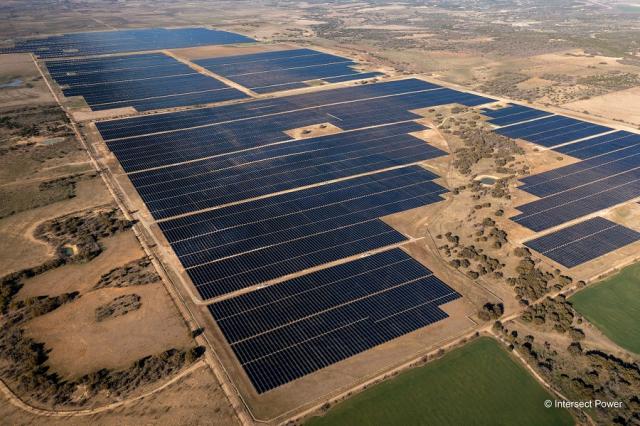
Intersect Power’s Radian Solar project located in Brown County, Texas, generates 415 MWp/320 MWac of solar energy, enough to power more than 114,000 homes. (Source: Intersect Power)
Delayed projects are slowing the pace of the clean energy transition as investment and incentives continue to roll in alongside challenges, an industry energy association said this week.
Growth, nonetheless, is still happening.
The American Clean Power Association (ACP), which regularly tracks clean energy production and manufacturing projects in the U.S., reported about 55 gigawatts (GW) of projects are facing delays and have not come online as expected. This includes more than 17 GW of delays so far this year.
“We’re really not moving fast enough, especially if we think about the goals of the energy transition and progress toward net-zero emissions in the system. And delays are a big part of the reason why,” John Hensley, vice president of research and analytics for ACP, said during an Aug. 15 webcast.
While the average delay is around 13 months, he said some projects are experiencing multiyear delays and others are a few months behind schedule.
The solar sector, which has accounted for most of the growth in U.S. utility-scale capacity additions, has been impacted the most by delays.
“Roughly 68% of all projects that are delayed at this point are solar projects, and there are lots of factors that go into the delays,” Hensley said, “but we can probably boil it down to a few key ones: uncertain trade regime, persistent supply chain kinks, interconnection delays and difficulty actually connecting to the grid are at the top of the list.
“Again, as we look towards a future where deployment will need to triple, it is imperative that we find solutions to these challenges and enable these projects to move at a faster clip.”
The comments were delivered as the U.S. and other parts of the world race to slow climate change by using more renewable and lower carbon resources to lower emissions. Efforts to hit targets, including 100% carbon pollution-free electricity by 2035 and net-zero emissions by 2050, have been strengthened by billions of dollars in incentives to spur development.
RELATED: IRA One Year Later: Progress, But a Long Way to Go
Despite the delays for some projects and a few down quarters since second-half 2022, progress is still being made. Overall, second-quarter 2023 installations are trending in a positive direction for renewable energy projects.
“Developers in this quarter commissioned just over five gigawatts from April to June, vaulting it to a silver medal position for second quarter activity,” he said. “So, this was the second best second quarter on record behind only the second quarter of 2021. At the halfway point of 2023, total installations for the year are 9,400 megawatts. …We think we’re going to have a continual uptick in 2023 numbers throughout the rest of the year.”
Solar led second-quarter 2023 installations.
Utility-scale solar
ACP data show 2,740 MW of solar capacity was added to the grid during the second quarter, rebounding to 2022 levels.
“With those additions, there is now 79,800 megawatts of solar operating in the U.S. and it is present in all 50 states plus the District of Columbia. Texas led solar installations in the second quarter after adding 529 megawatts,” Hensley said.
Making up a huge chunk of the additions in Texas was Intersect Power’s Radian solar project in Brown County, Texas. In June, the company announced the start of operations for the 415-MW project, providing enough energy to power more than 114,000 homes.
Battery storage
Battery storage saw double-digit growth, with 1,500 MW in installations commissioned during the second quarter. That’s a 32% increase from the same period last year.
“Now, despite a slow first quarter, which is kind of the story for all the technology, year to date battery storage installations are up 8% on the year,” Hensley said. “We saw 31 battery storage projects complete in the second quarter [of] 2023. Seventeen of those projects were standalone,” not connected to wind or solar.”
Land-based wind
For wind projects, nearly 1 GW of land-based wind was added to the grid in the second quarter as six new projects were commissioned.
“The wind space has been a little bit troubled over the past couple of years as we’ve seen installation fall following the peak in 2020 [to] 2021,” Hensley said. “A lot of this is due to a period of policy uncertainty given the expiration of the PTC [production tax credit] and prior to the incorporation of the Inflation Reduction Act. We do believe we’re at the nadir of this trend.”
The quarter was the second-lowest quarter for onshore wind installations since 2019.
“We expect wind activity to pick up as developers start to react to the long-term policy certainty that is in place,” he added.
Recommended Reading
US Refiners to Face Tighter Heavy Spreads this Summer TPH
2024-04-22 - Tudor, Pickering, Holt and Co. (TPH) expects fairly tight heavy crude discounts in the U.S. this summer and beyond owing to lower imports of Canadian, Mexican and Venezuelan crudes.
What's Affecting Oil Prices This Week? (April 22, 2024)
2024-04-22 - Stratas Advisors predict that despite geopolitical tensions, the oil supply will not be disrupted, even with the U.S. House of Representatives inserting sanctions on Iran’s oil exports.
Texas LNG Export Plant Signs Additional Offtake Deal With EQT
2024-04-23 - Glenfarne Group LLC's proposed Texas LNG export plant in Brownsville has signed an additional tolling agreement with EQT Corp. to provide natural gas liquefaction services of an additional 1.5 mtpa over 20 years.
Hedge Funds Retreat from Oil as War Risk Fades: Kemp
2024-04-29 - Hedge funds and other money managers sold the equivalent of 95 MMbbl in the six most important petroleum futures and options contracts over the seven days ending on April 23.
What's Affecting Oil Prices This Week? (April 29, 2024)
2024-04-29 - Stratas Advisors says even with the reported drawdown in U.S. crude inventories, the price of Brent crude oil remains below the upward channel that had been in place since January of this year.




